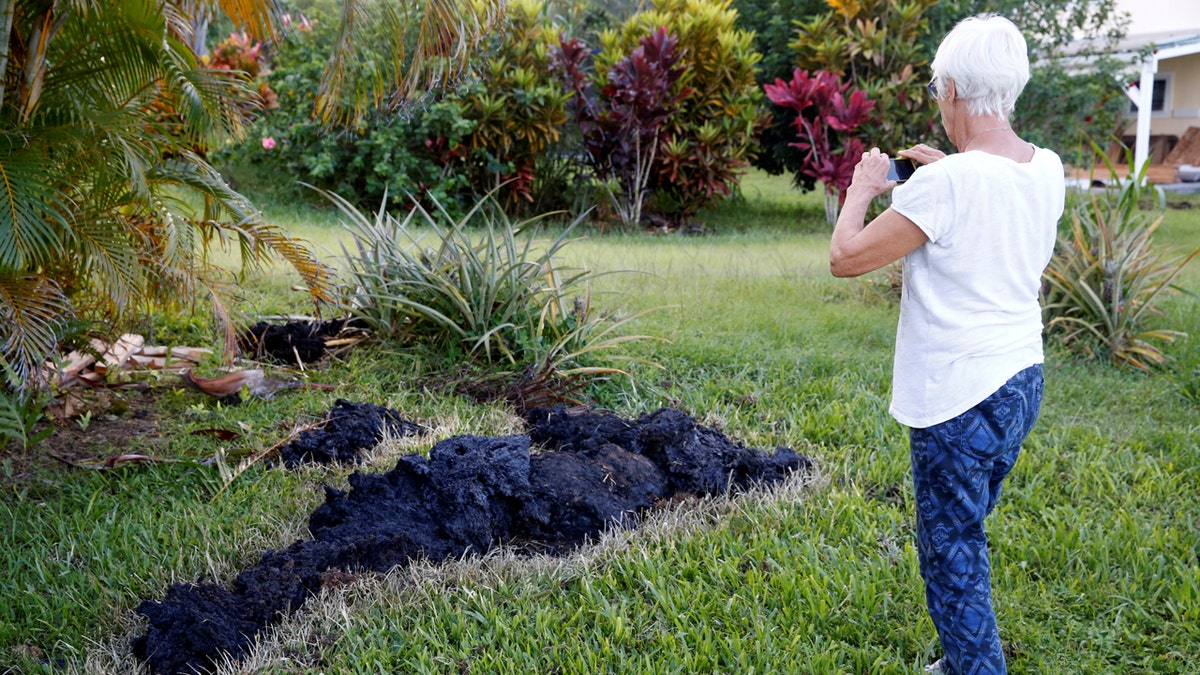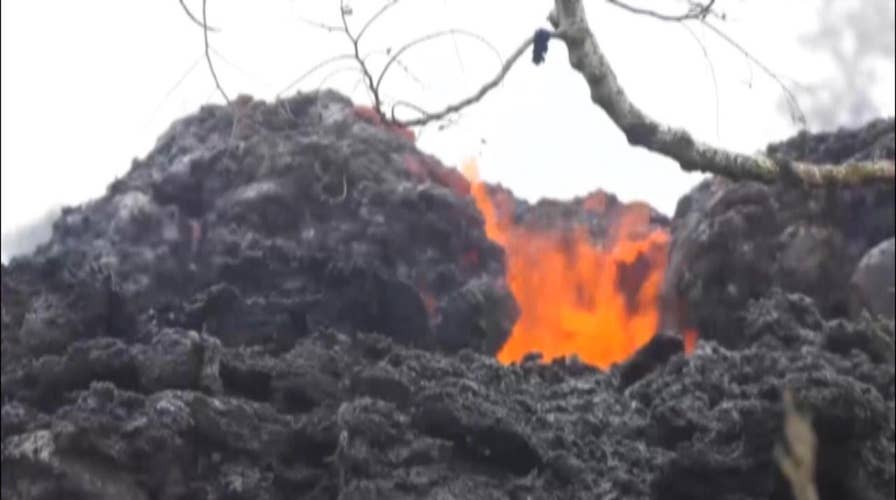New toxic gas volcano warnings issued in Hawaii
A look at how new warnings about toxic gas stemming from Hawaii’s volcano are prompting more evacuations and creating greater health hazards.
With Hawaii’s Kilauea volcano wreaking devastation on parts of the Big Island, experts are weighing possible worst-case scenarios for the disaster.
On Monday, another fissure spewing lava and unhealthy gas opened up; and a crack in the Earth that emerged a day earlier was sending molten rock on a slow run for the ocean, officials said.
Nearly 20 fissures have opened since the Kilauea volcano started erupting 12 days ago, and officials warn it may soon blow its top with a massive steam eruption that would shoot boulders and ash miles into the sky.
HAWAII VOLCANO EVACUATION ALERT MAY ARRIVE ON SHORT NOTICE, OFFICIALS WARN
“The worst case is a long-lived eruption that spreads down the rift to the Pacific, mostly because it exposes more homes and businesses to lava flows,” Dr. Erik Klemetti, associate professor and chair at the Department of Geosciences at Denison University, told Fox News via email.

Lava erupts from a fissure east of the Leilani Estates subdivision during ongoing eruptions of the Kilauea Volcano in Hawaii, U.S., May 13, 2018. (REUTERS/Terray Sylvester)
“An explosive eruption from the summit would cause damage to the structures at the summit like the Hawaii Volcano Observatory or the Jaggar Museum & Overlook,” he added.
Part of the U.S. Geological Survey's Volcano Hazards Program, the Hawaii Volcano Observatory is perched on the rim of Kīlauea’s summit caldera. The Thomas A. Jaggar Museum, which is operated by the National Park Service, is located next to the Volcano Observatory.
Einat Lev, Lamont Assistant Research Professor at Columbia University agrees that summit damage and a long-running eruption are possibilities. “In my opinion, the worst scenario includes a combination of large (for Hawaii) explosion at the summit combined with extended (many months) effusion of lava at the lower East Rift Zone,” she told Fox News, via email. “Such extended effusion will hamper any rebuilding efforts in that part of the island.”

Lava erupts from a fissure on the outskirts of Pahoa during ongoing eruptions of the Kilauea Volcano in Hawaii, U.S., May 14, 2018. (REUTERS/Terray Sylvester)
Rift zones are areas where the volcano is “rifting” or splitting apart, according to the University of Hawaii at Hilo. Because the rocks in rift zones have multiple cracks and are relatively weak, it is easy for magma to make its way to the surface in these areas, it explains on its website.
The volcano, one of the most active in the world, has already destroyed dozens of homes since its latest eruption began. President Trump declared a major disaster area in Hawaii on May 11.
The Hawaiian Volcano Observatory reported a fissure opened Saturday just east of the Puna Geothermal Venture energy conversion plant, where steam and hot liquid are brought up through underground wells and the steam feeds a turbine generator to produce electricity.
KILAUEA VOLCANO COULD LAUNCH 10-TON BALLISTIC BOULDERS IN DRAMATIC EXPLOSION

View of the Hawaii's Kilauea Volcano from the International Space Station in this undated image obtained from social media and tweeted on May 13, 2018. (Andrew J. Feustel/NASA/via REUTERS)
As a precaution, plant workers last week removed 50,000 gallons (189,265 liters) of a flammable liquid stored at the site.
Dr. Jessica Johnson, lecturer in geophysics at the University of East Anglia in the UK, told Fox News that the worst-case scenario is for "more of the same" in the volcano's lower East Rift Zone."There is the potential for more fissures to open and for the lava to become more voluminous and fast flowing, destroy more homes and infrastructure, even the geothermal power plant," she explained, via email.
The geophysicist also acknowledged the possibility of large explosions if falling rocks trap steam rising from Kilauea. "These explosions could project ballistics up to 2 m [6.6 feet] across as far as a kilometre [0.6 miles]. Smaller particles may be ejected further, and ash could reach kms into the atmosphere. This scenario last happened in 1924," she wrote.
INCREDIBLE PHOTOS SHOW HAWAII'S KILAUEA VOLCANO ERUPTION SPOTTED FROM SPACE
Johnson notes, however, that Kilauea's summit is inside the Hawaii Volcanoes National Park and not in a residential area, "If this [major explosion] happened, nobody's lives would be in danger as long as people listen to the authorities and respect the evacuation areas," she said.
Despite the worrying scale of the Kilauea’s latest spate of activity, Klemetti said there is “very little-to-no chance” that the volcano could have a global impact, or even impact the Hawaiian towns of Hilo or Kona.
So, what’s the best-case scenario for the eruption?
“Best case is easy: the eruption ends soon,” said Klemetti. “The supply of magma from the summit drops, so the lava being fed into the fissures runs out.” While this is a possibility, the expert noted that similar eruptions in the past have gone on for weeks or even months.
HAWAII'S KILAUEA VOLCANO'S ACTIVE HISTORY, AND THE SCIENCE BEHIND THE MOST RECENT ERUPTION

Patricia Spinoza, of Puna, takes a photo of lava on a lawn on the outskirts of Pahoa during ongoing eruptions of the Kilauea Volcano in Hawaii, U.S., May 14, 2018. (REUTERS/Terray Sylvester)
“The key to remember for Kilauea is that most of the eruptions, because they are lava flows, are hazardous to property and infrastructure but not particularly dangerous to people as they can be evacuated,” he added.
Columbia University’s Lev agrees that a rapid decline in the magma supply is the best possible outcome, one which would see “things quiet back down.”
Late on Monday officials gave an update on volcano’s East Rift zone, warning that fissures in the southeast of the Lanipuna Gardens neighborhood are issuing high levels of Sulfur Dioxide gas. Hawaii County Civil Defense warned residents that air quality in the area poses an immediate threat to health.
Klemetti told Fox News that the volcanic gases are mostly water vapor, carbon dioxide and sulfur dioxide. “The sulfur dioxide can react with water to form acid, so if you breathe it in, you can damage your lungs, throat and nose and irritate your eyes,” he explained. “If the vapor is particularly dense or you’re already susceptible, it could kill you — which is again why people need to evacuate. Luckily, it disperses quickly so people further away don’t need to be concerned about death but rather irritation.”
The Associated Press contributed to this article.
Follow James Rogers on Twitter @jamesjrogers




















